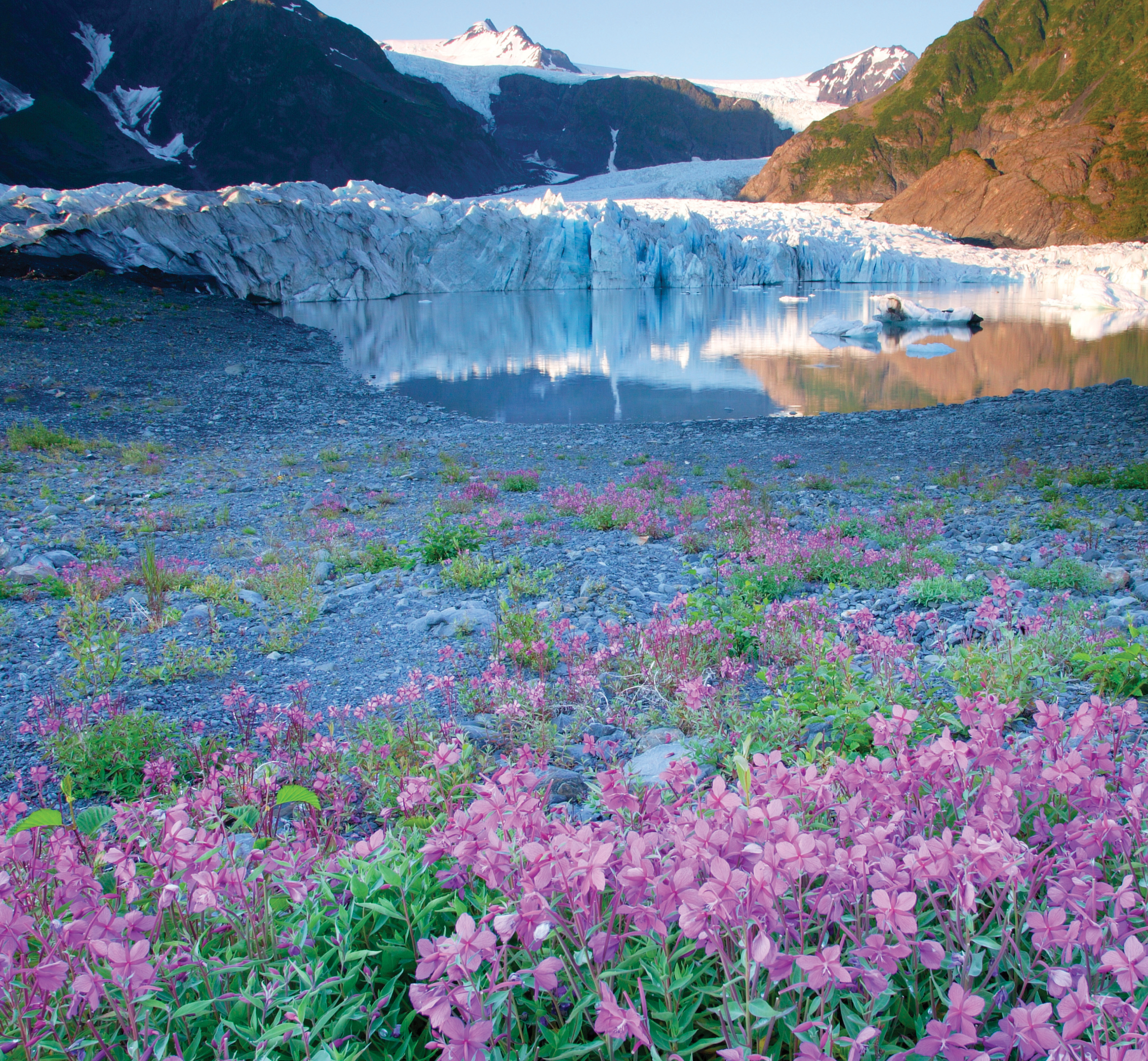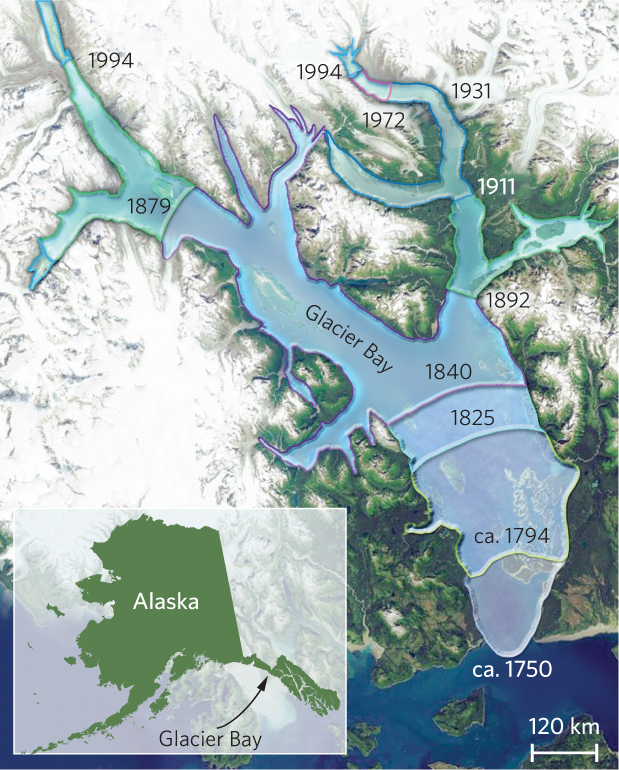Chapter 19
Community Succession
442

443
CHAPTER CONCEPTS
- Succession occurs in a community when species replace each other over time.
- Succession can occur through different mechanisms.
- Succession does not always produce a single climax community.
Retreating Glaciers in Alaska
In the panhandle of Alaska near Juneau, a stretch of land has undergone incredible changes during the past 200 years. In 1794, Captain George Vancouver found an inlet that headed toward modern-day Juneau. To the north of the inlet was a massive glacier that measured more than 1 km thick and 32 km wide. When the naturalist John Muir visited the glacier site in 1879, 85 years after Captain Vancouver’s expedition, he was shocked to find that the glacier had receded nearly 80 km and left behind a large bay. Moreover, while most bays in Alaska were heavily forested, the shores of this new bay were relatively barren. As Muir explored, he found several locations with large stumps that were the remnants of hemlock, black cottonwood (Populus trichocarpa), and Sitka spruce trees that had been sheared off by the glacier as it advanced centuries earlier. Muir had no way of knowing that he was looking at one of the fastest melting glaciers in the world.
“When the naturalist John Muir visited the glacier site in 1879, 85 years after Captain Vancouver’s expedition, he was shocked to find that the glacier had receded nearly 80 km and left behind a large bay.”
John Muir’s writings about the natural world were widely read. In 1916, William Cooper, an ecologist who was particularly intrigued by Muir’s stories of Alaska, made the first of several expeditions to the site that came to be known as Glacier Bay. On these expeditions, he surveyed the plants growing at various sites along the shore of the bay, including sites where the glacier existed during Vancouver’s visit, sites where the glacier existed during Muir’s visit, and sites where the glacier had receded only recently. He also set up quadrats around the bay to record the changes in vegetation at various locations that he planned to check when he returned on subsequent expeditions.

Cooper reasoned that sites exposed for the longest duration would have the most time to grow back into the kind of forest that had existed before the glaciers had advanced centuries earlier. In contrast, he expected recently exposed sites to be bare rock and gravel, representing the first stages of a developing forest. On these recently exposed sites, Cooper found mosses, lichens, herbs, and low shrubs. Sites that had been exposed for 35 to 45 years had tall species of willow and alder shrubs and black cottonwood trees. Sites older than 100 years contained Sitka spruce trees, and sites older than 160 years had hemlock in the understory. By examining changes in the plant community at sites that had been exposed for different lengths of time, he was able to hypothesize how the forests of Alaska responded to the massive disturbance of an advancing and retreating glacier.
444
The observations of Vancouver, Muir, and Cooper paved the way for more than a century of subsequent ecological research at Glacier Bay. In fact, the original terrestrial quadrats set up by Cooper are still monitored today, as are local streams that have been created by the melting glacier. As we will see in this chapter, long-term changes in ecological communities follow predictable patterns, which are important for us to understand the ways in which terrestrial and aquatic communities change over time and the processes that underlie these changes.
SOURCES: W. S. Cooper, The recent ecological history of Glacier Bay, Alaska II: The present vegetation cycle, Ecology 4 (1923): 223–246.
C. L. Fastie, Causes and ecosystem consequences of multiple pathways of primary succession at Glacier Bay, Alaska, Ecology 76 (1995): 1899–1916.
 Because ecological communities typically experience little change over weeks or months, it is tempting to think of a community as a static collection of species. However, communities commonly experience changes in species composition and relative abundance over longer periods. Such changes in communities over time are especially evident when a community experiences a major disturbance, like the receding glacier at Glacier Bay. Other examples include a field that has been plowed, a forest that has experienced an intense fire, or a pond that has dried during a drought but subsequently refills. In these cases, the community slowly rebuilds and, given sufficient time, it often resembles the original community that existed prior to the disturbance. In this chapter, we will explore how the composition of species in communities changes over time. We will also discuss the evidence that scientists have used to quantify these changes in both terrestrial and aquatic communities and describe how modern studies have altered original hypotheses. Understanding such changes is critical for scientists trying to predict how communities might respond to future environmental disturbances, such as hurricanes and fires, or the results of anthropogenic activity such as logging and mining. Such an understanding is also critical for scientists who try to predict the impacts of larger disturbances such as global climate change.
Because ecological communities typically experience little change over weeks or months, it is tempting to think of a community as a static collection of species. However, communities commonly experience changes in species composition and relative abundance over longer periods. Such changes in communities over time are especially evident when a community experiences a major disturbance, like the receding glacier at Glacier Bay. Other examples include a field that has been plowed, a forest that has experienced an intense fire, or a pond that has dried during a drought but subsequently refills. In these cases, the community slowly rebuilds and, given sufficient time, it often resembles the original community that existed prior to the disturbance. In this chapter, we will explore how the composition of species in communities changes over time. We will also discuss the evidence that scientists have used to quantify these changes in both terrestrial and aquatic communities and describe how modern studies have altered original hypotheses. Understanding such changes is critical for scientists trying to predict how communities might respond to future environmental disturbances, such as hurricanes and fires, or the results of anthropogenic activity such as logging and mining. Such an understanding is also critical for scientists who try to predict the impacts of larger disturbances such as global climate change.